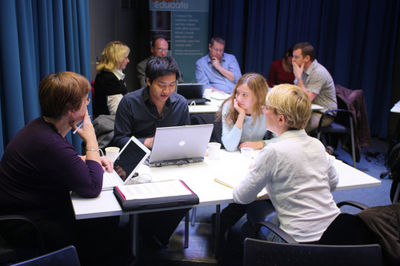Learner Centred Learning/LCL Learning Module
Contents
[hide]Learner Centred Learning
If you haven't been involved with the Gaining Foundation Skills course and would like a larger overview you may wish to start with this GFS learning module
Learning is all about the way in which we take in and process knowledge and experience and make meaning of what we encounter.
Approaches to Learning
If you haven't explored approaches to learning previously think about the following:
In exploring adult learning there are several key factors to consider when thinking about how people learn and the ways in which they make meaning of information and experience. The first is the approach to learning. This can occur on different levels. The most significant being a deep learning approach compared to a surface learning approach.
Surface Learning
- Learning to specifically meet course requirements
- Studying unrelated bits of knowledge
- Memorising facts and figures to repeat
- No linking or connection of learning
The surface approach to learning comes from “the intention to get the task out of the way with minimum trouble while appearing to meet course requirements” (Biggs, 2003, p14). This often includes rote learning content, filling an essay with detail rather than discussion and list points rather than providing background or context to the work.
Deep Learning
- Learning that seeks to understand and connect the concepts
- Relates ideas to previous knowledge and experience
- Explores links between evidence and conclusions
- Critiques arguments and examines rationale
The deep approach comes “from a felt need to engage the task appropriately and meaningfully, so the student tries to use the most appropriate cognitive activities for handling it” (Biggs, 2003, p16). Using this approach students make a real effort to connect with and understand what they are learning. This requires a strong base knowledge for students to then build on seeking both detailed information and trying to understand the bigger picture.
Strategic Learning
- Learning to achieve highest possible grades in a course
- Focused on assessment requirements and criteria
- Effort to understand knowledge to demonstrate learning
- Focused on perceived preferences of lecturer
Strategic learning, can be considered to be a balance between the other two approaches.
Reflection
Ponder the following questions:
|
The difference between Learner Centred Learning and Teacher Centred Learning
Lets consider the characteristics of a learner centred and a teacher centred approach.
Learner centred learning is based on 3 key factors:
- constructivism (based on the belief that learners develop new knowledge through building on previous knowledge and experience),
- deep learing (where learners actively engage with meaning),
- and learner self responsibility.
Teacher centred learning is based around:
- the teacher transmitting knowledge to the learner,
- the learner passively receiving information
- and it is the teacher who controls the learning.
Have a look at this comparison from the University of Connecticut.
|
Five areas of difference

- Balance of Power
- Function of Content
- Role of the Teacher
- Responsibility for Learning
- Purpose and Process of Evaluation
Again consider whether or not you would agree with these differences then ask yourself:
What do your answers suggest about the approaches used in the area you work in? Why do you think this is?
|
When you have completed this module share your thoughts and learning on the Moodle Discussion board
Additional Resources
This is for those seeking more information, it is not core course material. Approaches to Study “Deep” and “Surface” - an easy to read site described by the author, James Atherton as a "quick and dirty" overview exploring deep and surface approaches to learning
Deep and Surface Approaches to Learning - a page from within The Higher Education Academy's UK website that provides another perspective and more information although it does take the crude viewpoint that "deep is good, surface is bad, and we should teach in a way that encourages students to adopt a deep approach; although achieving this is not so easy".
Student-centred learning: What does it mean for students and lecturers? An interesting paper that explores the use of the term student-centred learning (SCL) within the education literature. Links in a wide range of literature.
Learner-Centredness:An Issue of Institutional Policy in the context of Distance Education This paper explores learner-centredness in relation to pedagogy, constructivism, changing roles of teachers and institutional policy.
For those of you interested in a little more about learning styles, this brief comment on Diverse Learning Styles in Your Classroom has 2 useful links to more information on Kolb’s learning style inventory and Gagne’s types or levels of learning.
References
Biggs, J. (2003). Teaching for quality learning at University (2nd ed.). London: The Society for Research into Higher Education & Open University Press.
Weimer, M. (2002). Learner-centered teaching:five key changes to practice. San Francisco:Jossey-Bass




